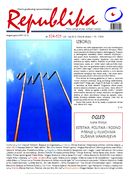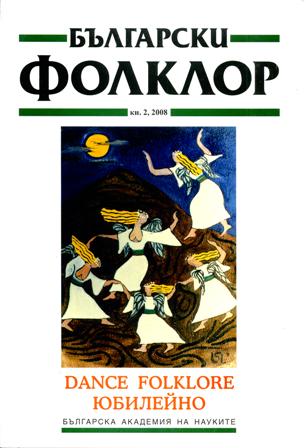
Estetics, Politics and Gender Issue in Dusan Makavejev Movies
Estetika, politika i rodno pitanje u filmovima Dušana Makavejeva
Keywords: Dusan Makavejev; motif; film director
More...
Keywords: Dusan Makavejev; motif; film director
More...
Keywords: Photography; Exhibition; €uroXibition
More...
Keywords: Metals bank; Privatisation; corruption
More...
Keywords: Serbia; corruption
More...
Keywords: Serbia; Elections 2012
More...
Keywords: Verica Barac; In memoriam; press conference; protest
More...
Keywords: Serbia; Elections 2012
More...
Keywords: Serbia; Elections 2012; Campaigns
More...


Jubilee
More...
Feminine and masculine in Bulgarian music folklore find expression in specifically feminine and masculine performance, feminine and masculine vocal training, feminine and masculine participation in the ritual and custom musical tradition, feminine and masculine repertoire. Series of historical, religious, moral and ethical changes in the Bulgarian folk society seem to be stimulating the development and changes in this musical opposition. The dialect parameters of the opposition masculine-feminine are also interpreted in the inquiry. Modern aspects of relations and mutual infiltration of the masculine repertoire and masculine performance style and the feminine practices and vice versa have been outlined.
More...
The study by R. Katsarova Horos and Dances from the Region of Gotse Delchev is a regional research of the folk dance riches of one district in South-Western Bulgaria. She shares her observations, analysis and summaries concerning the preserved old folk dances, studied during the period from 1946 to 1958. The study contains historical information about the population of the region — local people and immigrants from the former southern outlying districts of Bulgaria as well as of Bulgarian Christians and Bulgarian Muslims. The author extensively characterizes the horos and dances in style and performance, in structure, rhythm, tempo, form and expression. She presents the elder clothing and the typical vocal and instrumental accompaniment. The article traces also the state of horos and dances connected to some ancient customs, preserved up to this day, such as Lazaruvane, St. George's Day, Enjovden (Midsummer Day), weddings etc.
More...
The brothers Vladimir and Mitko Mitev from Vladaya Village are a duet, performing authentic twovoice songs from the Shopluk region. This circumstance throws new light upon the research of many specialists in folklore who have found up to this moment that in the Shopluk region the two-voice song is performed only by women. On the other hand, the Mitev Brothers are firm in their position that this type of singing has always existed and is the result of preserved family traditions. Mitko Mitev sings first voice and according to the local terms is called "okach", meaning "the one who calls". Vladimir Mitev is second voice and he is the so called "vlachach", or "helper". The repertoire of the Mitev Brothers is extremely rich and includes different Shops' customs, labor songs, table songs, horo songs and others. They add sometimes their own created songs, which have the style and the typical sounding of the Shops' song. It is characteristic that the Mitev Brothers sing with the same love and devotion for one person as for a. big audience, which makes the contact with them unique — as they themselves are.
More...
The article discusses the relation between music players and the dancers of the ring chain dance ("horo") in traditional culture through the eyes and experience of the folk musicians. The information collected in field interviews about the music playing for the "horo" outlines diverse means of communication, defined by the social normative requirements for the specific communicative situation on the part of the community as well as according to the fine mechanisms of "happening" of the communicative act during shared participation in the horo as a creative proceeding event. The article elaborates the social necessity to have a music player at the horo, the principles of mutual exchange of skills and values for the benefit both of the individual position of the music player of the horo and the dancers, who lay their conditions as a cultural commission. A next stage of extending the relationship is the correlation between the language of music and movement in the process of immediate communication in the horo. Comprising and structuring the instrumental horo music challenges the players and gives them freedom to sophisticate the language of the dance. On the other hand, the morphology of the horo melody depends on the mood of the dancers. The mutual commitment seems to be a result of accumulation of united dancing-and-musical energy. Within the minds of the participants in the dance event the instrumental music and the rhythmicand- movement activity are inseparable. The musician and the horo-dancers are two parties with equal participation in a wholesome process. The relation between them manifests in two types of behavior at different levels — in social perspective and as "musical" proceeding of the music-and-dancing act.
More...
The heritage of traditional dance has been object to diverse ways of teaching and practicing dancing skills. The article traces the traditional forms of dance training, which play a decisive role in mastering, transmission and developing of dance culture. Dance training in folk culture passes through different stages so that every one can take part in the horo during holidays — imitating the grown-up and almost daily dancing. Specific situations to teach and perfect dancing skills can be outlined: from the typically childish plays of the girls and boys to the transition to the youngsters' neighborhood horo and dancing out of village. Examples are given from the village Gorni Bogrov in the Sofia region, connected with the traditional training in dancing activities, valid to a great degree for the Bulgarian village from the beginning of the 20th century.
More...
The article elaborates some of the folk concepts about "life" of man after physical death and their parallels with the Chuvash people, Balkartsi and Bulgarians on the Balkans. This is a part of a research work on the ancient Bulgarian religious beliefs (along the traces from the Bulgarian state formations in North Caucasus and the Volga River), which cannot be unlocked without attending to folklore material. The present text is based on material both published by observers and collected by me, mainly among the Chuvash people, whom science accepts to be a substratum population from Volga Bulgaria, having preserved to a maximum degree their kinship with the language and the traditional culture of Bulgarians. It is known that within the intensively active zones of ethno-cultural contact (such as the Volga River, the Balkans, North Caucasus etc.) multiple components within the sphere of the folk tradition are manifested in similar contents and in similar ways. Today many of them "show" new context and conceptual level. The common worldview, on which many customs and rituals are founded, including the rites of transition and their symbolism, is a result of a century-old, synchronistic process of formation and functioning of the so called Indo-European ethno-cultural model. Many of its components are not a matter of specific origin and national belonging, but a specific way of manifestation of ritual behavior and concepts as a synthesis of cultures. The mainstay for their understanding is the conservative and ancient character of many inherited folk evidence as well as the social and political destiny of the population. The connection between burial and memorial rituals of the Chuvash people and the Bulgarians is found in concepts, actions and ritual practices, in material and space parameters and their semantics, in the typical anthropomorphic view of the permanent memorials and the recurrent forms of temporary memorials etc. The manifestation of those parallels at different levels in rituals and faith points to unity of ritual thinking and system and to the religious type, which keeps them in the memory of generations (under the form of continuity of ideas, ritual behaviors etc.)
More...
The article refers to interesting and not discussed problems — the lack of functional attachment of the Rhodopa songs as well as ornaments as a specific code in rituals. Referring to the first problem — there may be found a different cause for the dissociation of functionality in the song cycles from the Rhodopa Mountain in comparison to the same process observed in other folk regions. The reason for dropping out of the function is dissociation of the folk system, caused by change in the social existence of Bulgarians. This dropping out of the function has occurred much earlier in the Rhodopa Mountain in comparison to other regions because of the adoption of Islam among the population. This changed the social existence both of the Bulgarian Mohammedans and the Bulgarian Christians. The article refers also to another interesting phenomenon — marking of rituals with a specific musical code — ornaments. It becomes clear from the analysis that the ritual songs have specific structure, characterized with the limited immanent development of the music components, including ornaments. The reason to apply means of expression in such "ascetic" manner is due I think to the strong syncretism, which on the one hand unites the elements in a syncretic whole, but on the other hand hinders the specific development of each element — music, dance and word.
More...
The paper presents the composer T. Popov in the light of the personal meeting with him and the author's acquaintance with him. The creative work of T Popov in song adaptations is analyzed in different aspects — types of songs, which the composer remakes, his creative style in adaptation of the song material, melodic and harmonic devices etc. Special attention has been paid to the remakes by T. Popov of Bulgarian folk songs from different regions, where the ambition to keep the regional melodic and rhythmic specifics of the song is clearly outlined. A brief summery has been made to the creative work of T Popov in the field of solo song (mainly accompanied by a piano). The text emphasizes the significance of the creative work of a composer who should not be forgotten.
More...![Claire Levi. Ethno-Jazz: Local Projections Within the Global Village [in Bulgarian]. Sofia, Institute of Art Studies, 2007](/api/image/getissuecoverimage?id=picture_2008_19601.jpg)
Publications
More...